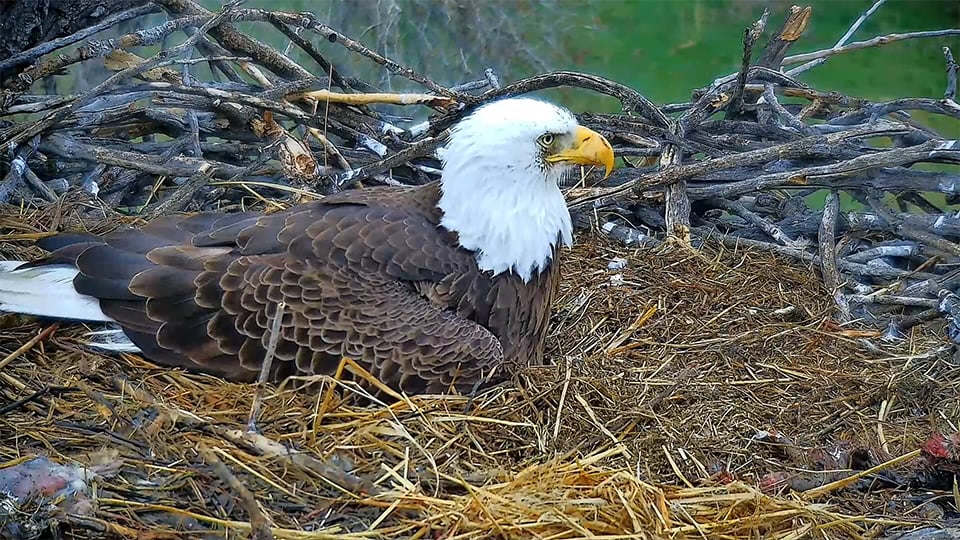About the Eagles
The Trempealeau eagles are nesting on private property in the city of Trempealeau, Wisconsin. Their nest is located in a white pine tree overlooking the Mississippi River. In general, the eagles begin courtship in October, productive mating in late January or early February, and egg-laying in mid to late February. Hatching usually begins in late March to early April, and the eaglets fledge in mid-to-late June. While young usually disperse between August and October, the adults remain on territory year round.
The eagles eat live and dead fish, squirrels, other birds, rabbit, muskrat, deer, possum and anything else they can catch or find. To learn more about bald eagles in general, please follow this link to the Cornell Lab of Ornithology website.
Adults
For now, we’re referring to the eagles as Mr. and Mrs. T. If that changes, we’ll let everyone know!
Nests
This is the only nest at this site, although others can be seen nearby. The eagles have occupied this nest for at least five years. It is roughly 65 feet off the ground.
Common name: Bald Eagle
Scientific name: Haliaeetus leucocephalus
Length: 2.3–3.1 feet | 71–96 cm
Wingspan: 5.9 – 7.5 feet | 1.7-2.2 meters
Weight: 6.5 – 13.8 pounds | 3–6.3 kilograms
Lifespan: Up to 40 years in the wild
Bald Eagle Vocalization
Learn More About Bald Eagles

Posted: April 19, 2024
We’re writing a series of blogs about the first few weeks of an eaglet’s life. An eaglet spends roughly 75 to 80 days in the nest. For about the first half, it grows and gains weight. For about the second half, it grows flight feathers and starts developing the skills it will need post-fledge. We will focus on week four in this blog. During week three (fourteen to twenty-one days), the dynamic duo shed most of their natal down, gained

Posted: April 19, 2024
Do bald eagles go through menopause? Probably not, since we’ve documented menopause or prolonged post-reproductive lifespans in just four species.

Posted: April 16, 2024
Eaglets go through two molts and three feather stages in the nest: natal down (and molt), followed by thermal down (and molt), followed by juvenile feathers. As of this blog, the Decorah North eaglets are shedding the very last of their natal down and their thermal down is rapidly being replaced by juvenile down and feathers. We thought we would blog a little more about feathers to celebrate! When we think about feathers, we tend to think about their qualities

Posted: April 14, 2024
As watchers know, Canada geese are nesting in two abandoned bald eagle nests in Decorah, Iowa. N2B – currently a goose nest – is located about 700 feet east of N1, where geese started hatching yesterday. This blog discusses some of the differences between altricial eagles and precocial geese! Altricial eaglets rely on parental care until they fledge. But goslings are precocial: capable of moving around, self-feeding, and leaving the nest shortly after hatch. What does that mean? Read on

Posted: April 8, 2024
We’re writing a series of blogs about the first few weeks of an eaglet’s life. An eaglet spends roughly 75 to 80 days in the nest. For about the first half, it grows and gains weight. For about the second half, it grows flight feathers and starts developing the skills it will need post-fledge. We will focus on week three in this blog. DN17 and DN18 turned 15 and 14 days old today. During week two (seven to 14 days),
Click for More About Bald Eagles  The Raptor Resource Project
The Raptor Resource Project The Raptor Resource Project
The Raptor Resource Project